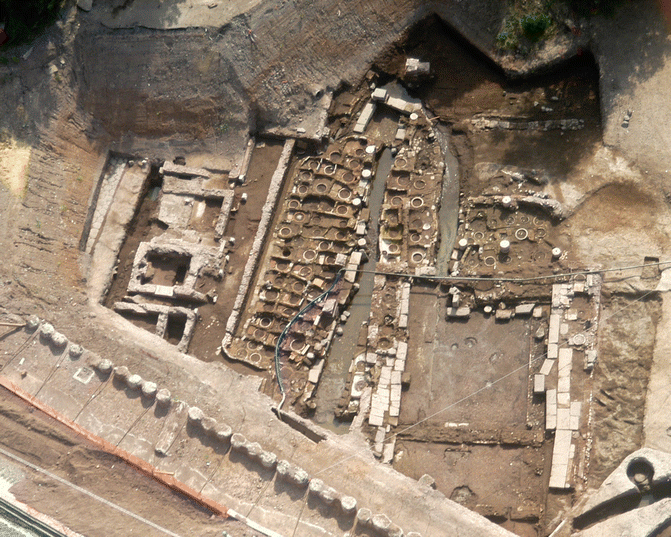, Paola Catalano1, Andrea Piccioli2, 3, Maria Silvia Spinelli4, 3 and Federica Zavaroni1
(1)
Anthropological Service, Soprintendenza Speciale per il Colosseo, il Museo Nazionale Romano e l’Area Archeologica di Roma, Rome, Italy
(2)
Oncologic Center “Palazzo Baleani” Azienda Policlinico “Umberto I”, Rome, Italy
(3)
The Italian Society of Orthopaedics and Traumatology (SIOT), Rome, Italy
(4)
Department of Orthopaedic and Traumatology, Catholic University Hospital, Rome, Italy
2.1 Data Description
Carla Caldarini5 , Paola Catalano5 and Federica Zavaroni5
(5)
Anthropological Service, Soprintendenza Speciale per il Colosseo, il Museo Nazionale Romano e l’Area Archeologica di Roma, Rome, Italy
This study examines the inhumed individuals of ten Imperial Age Roman graveyards (Fig. 2.1), from several different areas of the Suburb, and concentrates on subjects affected by pathological phenomena of great scientific interest.


Fig. 2.1
Location of the examined graveyards
2.1.1 Castel Malnome
The necropolis of Castel Malnome [1, 2], dating back to between I and II century A.D., extends for about 3,000 m2 on a sandy hill, near Ponte Galeria, close to the Via Portuense.
The graveyard excavation has unearthed 289 subjects, most of them inhumed, in a good state of preservation. The anthropological laboratory examination on 265 subjects, indicates a humble-class reference population, characterized by a sharp preponderance of male adults. The presence of clear stress markers due to hard work, has suggested the connection with the old Roman saltworks, found during the recent excavations in the nearby areas. One hundred and fifty-seven cases from the sample have been subjected to further palaeopathological examinations.
2.1.2 Collatina
The most numerically representative sample comes from the necropolis of Collatina [3–5], between Via della Serenissima and Via Basiliano, at about 3.5 km from the Aurelian Walls, having its northern border in the urban section of the A24 highway, and Via Prenestina as its southern border (Fig. 2.2). The necropolis, near the old Via Collatina, is composed of many pit graves and funeral monuments. The excavation of this graveyard, of likely urban fruition, has unearthed 2,164 subjects of both genders and of every age. The laboratory analysis has been currently carried out on a sample of 800 subjects, 19 of which re-examined from a palaeopathological point of view.


Fig. 2.2
Aerial view of the Collatina necropolis
2.1.3 Casal Bertone
In the area of Casal Bertone, in an eastern Roman suburb delimited by the Via Tiburtina to the north and the Via Prenestina to the south, an extensive archaeological research, prior to the implementation of the High Speed Train Railway, has unearthed several archaeological finds most likely related to one another [6, 7]: to the north, five funeral structures standing aligned next to a wide production plan, identified as a fullonica, and lying close to a road track (Fig. 2.3); to the east, the plan of a big villa, composed of a residential area and a monumental nymphaeum; to the south, a funerary area with a “sub divo” necropolis and a mausoleum; finally, to the west, a group of structures of uncertain identification. Overall, 221 subjects have been found, 190 of which are analysed in the laboratory. Among these, 28 have been re-examined from a palaeopathological point of view.


Fig. 2.3
Hot-air balloon view of the Casal Bertone site
The incidence of enthesopathic lesions and traumas, found in both sexes, as in the sub-adult section of the sample, suggests a reference population employed in hard work jobs, thus hypothesizing a link between the funerary complex and the nearby fullonica.
2.1.4 Padre Semeria
The necropolis in Via Padre Semeria [7], a side street off Via Cristoforo Colombo, is in the south of the Urbs, just outside the Aurelian Walls. The archaeological investigation has unearthed a total of 114 sub divo monuments and sepulchral sections, chronologically dating back to II and III century A.D. The laboratory anthropological analysis has been performed on 107 inhumed, 15 of which show noteworthy pathologies.
2.1.5 Osteria del Curato and Lucrezia Romana
This area is in the south-east quadrant of the Suburb, along the Via Tuscolana, close to the Grande Raccordo Anulare. The excavations have identified various sepulchral units, unearthing 410 subjects (Figs. 2.4 and 2.5). The uncovered sepultures are likely related to the agricultural buildings of the nearby villas Lucrezia Romana and Sette Bassi and so linked to the slave and wage worker units employed in the praedium, as the archaeological evidence seems to suggest [8–10]. The laboratory anthropological study has involved 223 subjects, 124 of which are re-examined from palaeopathological point of view.



Fig. 2.4
Panoramic view of the Osteria del Curato site

Fig. 2.5
Hot-air balloon view of one of the graveyards, Lucrezia Romana
2.1.6 Gabii
The archaeological park of the ancient Latin town of Gabii, is situated 20 km far from Rome, at the 12th mile of the ancient Via Prenestina. The ancient built up area stood on the southern ridge of the volcano of Castiglione, off-centred from the Alban Hills volcanic complex, containing a volcanic lake dried up in the nineteenth century. The 53 examined subjects from the Imperial Age (18 of which have been selected for the palaeopathological examination), come from the so-called Eastern Sanctuary, just east of the ancient town walls, clearly connected to a road track going to Tibur [11].
2.1.7 Quarto Cappello del Prete
The area known as Piano di Castiglione-Quarto Cappello del Prete [11] lies at about 1.5 km east of the town of Gabii, along the Via Prenestina Polense (Figs. 2.6 and 2.7). The necropolis lies in the furthermost south-west quadrant of the site and extends to the west of a monumental rectangular structure. The site, which covers a 40,000 m2 area, is composed of a series of north to south oriented buildings, most of which related to water management. Seventy per cent of the 120 examined subjects are children and young-age burials, most of which died under the age of 6.


Fig. 2.6




Hot-air balloon view of one of the burial sites, Quarto Cappello del Prete
Stay updated, free articles. Join our Telegram channel

Full access? Get Clinical Tree








